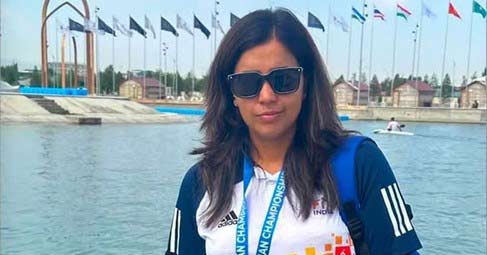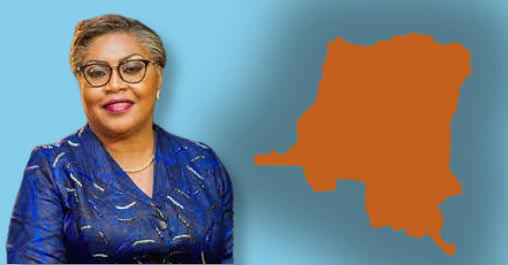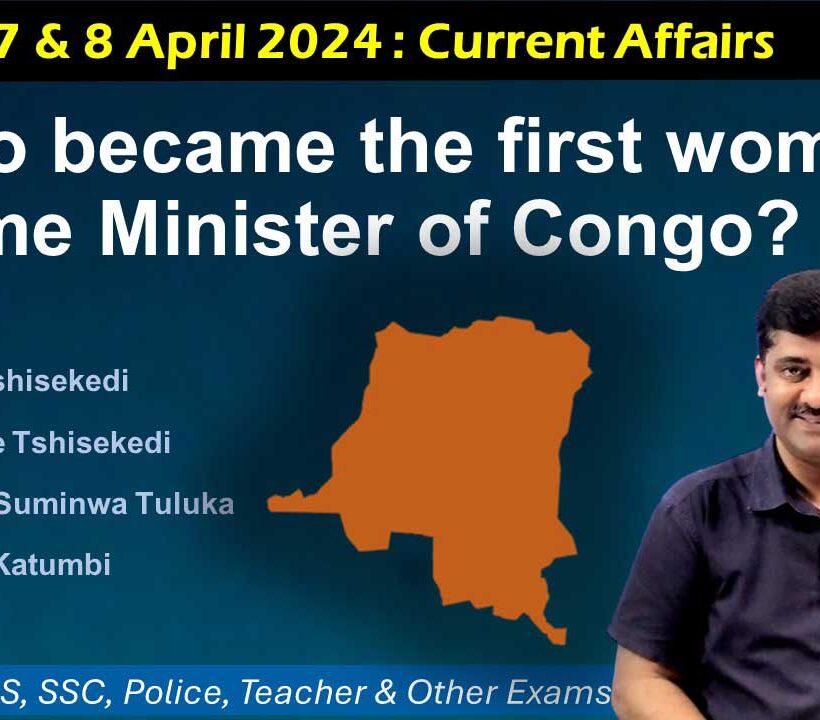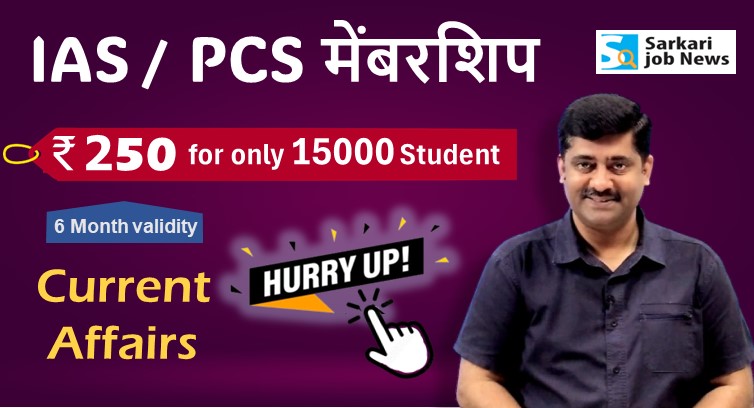This is the current affairs of 7 & 8 April 2024. Here are questions and answers of daily current affairs for better preparation of competitive exams for government jobs.
PDF Download: Click here
1. Who became the first woman from India to become a jury member in the Summer Olympics?
a. Anamika Verma
b. Bilquis Mir
c. Bilkis Bano
d. Rajni Das
Answer: b. Bilquis Mir

– The Paris Olympics will be held in Paris from July 26 to August 11.
– Bilquis Mir has been selected as a jury member for this.
– In any Summer Olympics, she is the first Indian woman jury member.
– She was nominated as a jury member by the Indian Kayaking and Canoeing Association for the Paris Olympic Games. After that, she has been appointed.
– This has been confirmed by the Indian Olympic Association.

About Bilquis Mir:
– She hails from Jammu and Kashmir.
– She is a water sports athlete and a canoeing champion.
– She started her canoeing career on Dal Lake in 1998 and later represented the country in various events.
– She has previously served as a jury member in the 2023 Asian Games held in Hangzhou, China.
————–
2. In which research station was it decided to open the second branch of the Indian Post Office in Antarctica, whose pin code is MH-1718?
a. ‘Yamunotri’ Research Station
b. ‘Maitri’ Research Station
c. ‘Dakshin Gangotri’ Research Station
d. ‘Bharati’ Research Station
Answer: d. ‘Bharati’ Research Station

Antarctica Research Stations of India:
– Currently, India has two research stations in Antarctica.
– Their names are ‘Maitri’ and ‘Bharati’.
– Maitri Research Station was established in 1989-90, and Bharati Research Station in March 2013.
– Research and investigations are conducted at both stations to understand polar processes and events. Observations and studies are carried out in various fields such as atmospheric, biological, geological, and environmental sciences.
What was the name of the first research station?
– Before ‘Maitri’ and ‘Bharati’ in Antarctica, there was another research station.
– Its name was ‘Dakshin Gangotri’, established in 1984.
– It was India’s first station in the icy continent. However, it submerged in the ice in 1988-89.
Indian Post Office in Antarctica:
– The first branch of the post office in Antarctica was on the ‘Dakshin Gangotri’ research station in 1984. But when the station submerged in ice in 1988-89, the post office branch was also closed.
– Later, when the Maitri Research Station was established (1989-90), the branch was started there.
– So now there are two branches of the post office in Antarctica.
– One branch is at the ‘Maitri’ Research Station, and the other branch is being opened at the ‘Bharati’ Research Station.
– After almost four decades, there will be a new PIN code, MH-1718, for the letters coming for Antarctica.
– Both branches are part of the Goa Postal Division.
How does mail reach Antarctica?
– “In practice, letters coming to the post office in Antarctica are sent to the National Centre for Polar and Ocean Research (NCPOR), Goa, India, which is the nodal agency for India’s polar campaigns.
– When a scientific expedition to Antarctica departs from NCPOR, typically, the responsibility of carrying the letters is assigned to a researcher.
– At the research station, the letters are ‘cancelled’, brought back, and returned through postal means,” said a postal department official.
– Officials said that ‘cancelling’ involves putting a mark on the postal ticket or stationery, which is done to invalidate the ticket and prevent its reuse.
– Typically, ‘cancelled’ letters include the date and location of the post office where the tickets were sent. For philatelists, they are crucial in determining the value of tickets.
Note:
– India aims to build its first Polar Research Vessel (PRV) in the next five years to maintain its presence in Antarctica.
– The government wants to build this icebreaker vessel in the country itself.
– An estimated cost of Rs 2,600 crore is projected for this project.
————–
3. When is World Health Day celebrated?
a. 7 April
b. 6 April
c. 5 April
d. 4 April
Answer: a. 7 April
Theme of 2024:
– My health, my right
– World Health Day is celebrated every year on the founding day of the World Health Organization (WHO).
– The WHO was established on this day in 1948.
– WHO is an autonomous organization working under the United Nations (UN) to promote global health issues.
– The main objective of World Health Day is to raise awareness among people about the health issues faced worldwide.
—————
4. The Department of Atomic Energy has set a target of increasing India’s nuclear power generation capacity from 8,000 MW to how much by the year 2047?
a. 60 thousand megawatts
b. 80 thousand megawatts
c. 1 lakh megawatts
d. 2 lakh megawatts
Answer: c. 1 lakh megawatt (100 gigawatt)

– Currently, India’s nuclear energy production capacity is 8,000 megawatts.
– Chairman of the Atomic Energy Commission, A.K. Mohanty announced in April 2024 that India’s goal is to produce 100,000 megawatts of nuclear energy by 2047.
– The Nuclear Energy Department is preparing a vision document for the ‘Amrit Kal’.
Nuclear Energy Situation in India:
– Nuclear energy is the fifth-largest source of electricity for India, contributing to about 3% of the total electricity production in the country.
– There are more than 22 nuclear reactors in 7 nuclear power plants across the country, producing 8,000 megawatts of energy.
– There are 18 Pressurized Heavy Water Reactors (PHWRs) and 4 Light Water Reactors (LWRs).
Nuclear Energy Plants in India:
1. Rajasthan Atomic Power Plant (RASP), Kota
2. Kakrapar Atomic Power Plant (KAPS), Tapi, Gujarat
3. Tarapur Atomic Power Plant (TAPS), Boisar, Maharashtra
4. Kaiga Generating Station (KGS), Kaiga, Karnataka
5. Narora Atomic Power Plant (NAPS), Narora, UP
6. Madras Atomic Power Plant (MAPS), Kalpakkam, Tamil Nadu
7. Kudankulam Nuclear Power Station (KKNPS), Kudankulam, Tamil Nadu
Government’s New Scheme:s
– Breeder reactors will contribute 3 gigawatts of nuclear energy, while 17.6 gigawatts will come from light water reactors built with international cooperation, and another 40-45 gigawatts will come from pressurized heavy water reactors.
– India is planning to gradually reduce coal usage in the next three decades in a phased manner.
————–
5. Which countries declared state of disaster in April 2024 due to devastating drought?
a. Zambia, Malawi, and Zimbabwe
b. Malawi, Mali, and Qatar
c. Zimbabwe, Congo, Guyana
d. All of the above
Answer: a. Zambia, Malawi, and Zimbabwe

– Alongside Zambia and Malawi, Zimbabwe has declared a state of emergency due to severe drought across southern Africa.
– President Emmerson Mnangagwa stated, “Inspired by El Niño-induced droughts… more than 80% of our country experienced below-normal rainfall. The top priority of the nation is to ‘ensure food security for all Zimbabweans. No Zimbabwean should die of hunger or starvation.”
– He immediately requested assistance of $2 billion to address the serious food shortage.
– He appealed to United Nations agencies, local businesses, and faith-based organizations to contribute to humanitarian aid.
Impact of El Niño:
– El Niño, a naturally occurring climate phenomenon, warms parts of the Pacific Ocean every two to seven years, affecting global weather patterns.
– Southern African countries usually experience below-average rainfall, but this year has seen the worst drought in decades.
– Zimbabwe, once a regional agricultural powerhouse and exporter of grain, has increasingly relied on aid agencies to mitigate large-scale hunger due to extreme weather conditions such as heatwaves and floods in recent years.
Zambia
– This is a landlocked country.
Capital: Lusaka
– President: Hakainde Hichilema
– Currency: Zambian Kwacha
Malawi
– This is a landlocked country.
Capital: Lilongwe
– President: Lazarus Chakwera
– Currency: Malawian Kwacha
Zimbabwe
– This is a landlocked country.
– Capital: Harare
– President: Emmerson Mnangagwa
– Currency: Zimbabwe Dollar, US Dollar, South African Rand
————–
6. When is International Day of Sports for Development and Peace celebrated?
a. 7 April
b. 6 April
c. 5 April
d. 4 April
Answer: b. 6 April
– This day is celebrated to highlight the importance of sports in society.
– The United Nations General Assembly (UNGA) declared this day in 2013.
————–
7. Who became the first woman Prime Minister of the Democratic Republic of Congo?
a. Felix Tschudi
b. Anton Tschudi
c. Judith Suminwa Tuluka
d. Moise Katumbi
Answer: c. Judith Suminwa Tuluka (Former Minister of Planning)

– She is 56 years old. She is the first female Prime Minister of Congo.
– The President of the Democratic Republic of Congo, Felix Tshisekedi, appointed the country’s first female Prime Minister on April 1, 2024.
– In her first speech after her appointment, she pledged to work towards peace and development.
Tensions Rising Between Congo and Rwanda
– According to the United Nations, there has been a long-standing conflict between Congo and Rwanda.
– Due to this conflict, more than 7 million people have been displaced.
This conflict has become one of the world’s worst humanitarian crises.
– Longstanding control by over 120 armed groups is prevalent in eastern Congo, far from the capital, Kinshasa.
– In March 2024, the United States urged both countries to “step back from the brink of war.”
DRC Congo
Continent – Africa
Capital – Kinshasa
President – Felix Tshisekedi
Currency – Congolese Franc
Neighbor countries – Republic of Congo, Central African Republic, South Sudan, Uganda, Rwanda, Burundi, Tanzania, Zambia, and Angola
————–
8. RBI did not change the repo rate in the bi-monthly monetary policy review (April 2024), what is this repo rate?
a. 5.5%
b. 5.8%
c. 6.2%
d. 6.5%
Answer: d. 6.5%
– The Reserve Bank of India’s Monetary Policy Committee (MPC) decided not to change the repo rate on April 5, 2024.
– The MPC of the RBI has kept the repo rate unchanged in the past seven meetings of the Monetary Policy Committee.
– Governor Shaktikanta Das stated that inflation is under control, hence the decision.
What is the Repo Rate?
– In simple terms, banks lend us money, and we have to pay interest on that loan.
– Similarly, banks also require a significant amount of money for their day-to-day operations, and they borrow from the Reserve Bank of India (RBI).
– The rate at which the Reserve Bank charges interest on this loan is called the repo rate.
Impact of Repo Rate on the Common Man:
– The repo rate is a powerful tool for combating inflation with the RBI.
– When inflation is too high, the RBI tries to reduce money flow in the economy by increasing the repo rate.
– When banks have access to loans at lower interest rates, meaning the repo rate is low, they can offer cheaper loans to their customers.
– And if the Reserve Bank increases the repo rate, borrowing for banks becomes expensive, and they will charge higher interest rates to their customers.
Reverse Repo Rate:
– This is the opposite of the repo rate.
– When banks have a surplus of funds after their day-to-day operations, they park that amount with the Reserve Bank.
– The RBI pays them interest on this amount.
– The rate at which the Reserve Bank pays interest on this amount is called the reverse repo rate.
Chairperson of the Monetary Policy Committee – Governor of the Reserve Bank of India, Shaktikanta Das.
————–
9. Which IIT developed India’s first recombinant vaccine for swine fever (a highly contagious viral disease of pigs)?
a. IIT Bombay
b. IIT Kanpur
c. IIT Delhi
d. IIT Guwahati
Answer: d. IIT Guwahati

– IIT Guwahati transferred its first-of-its-kind vaccine technology to Biomed Private Limited in March 2024.
– According to The Hindu newspaper, the recombinant vector vaccine has been designed specifically to combat classical swine fever virus in pigs and wild boars.
What is a Recombinant Vector Vaccine?
– A recombinant vector vaccine is a type of vaccine in which a portion of a virus or bacterium is transferred into another virus or bacterium.
– These portions provide immunity against that virus or bacterium.
What is Classical Swine Fever?
– Classical Swine Fever (CSF), also known as Hog Cholera, is a viral disease affecting domestic and wild pigs.
In Which States of India is this Disease Seen?
– Cases of this disease have been frequently observed in the northeastern states along with Bihar, Kerala, Punjab, Haryana, and Gujarat.
When Did the Work on the Vaccine Begin?
– The work on the vaccine began through collaborative efforts between the Department of Biosciences and Bioengineering at IIT Guwahati and researchers from Assam Agricultural University, Guwahati, in 2018-2019.
About Assam:
Chief Minister: Himanta Biswa Sarma
Governor: Gulab Chand Kataria
Capital: Dispur
Languages: Assamese, Bengali, Bodo
Population: 34.18 million (more than three crores)
————–
10. Kathia wheat got GI tag, belongs to which state?
a. Bihar
b. Uttar Pradesh
c. Madhya Pradesh
d. Rajasthan
Answer: b. Uttar Pradesh (Bundelkhand)
– The indigenous wheat variety of Bundelkhand region in Uttar Pradesh has been given the Geographical Indication (GI) tag named “Kathia Gehu”.
PDF Download: Click here




